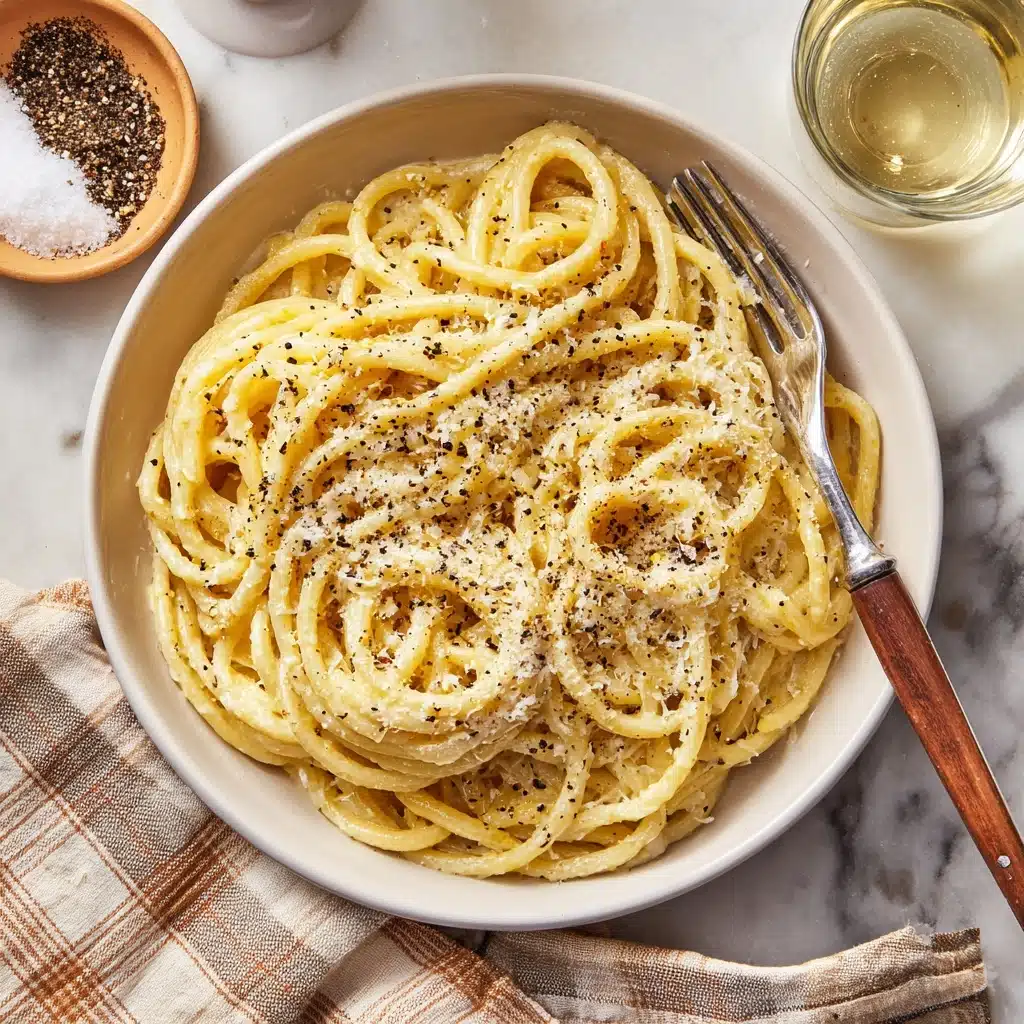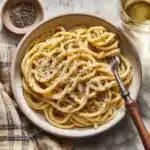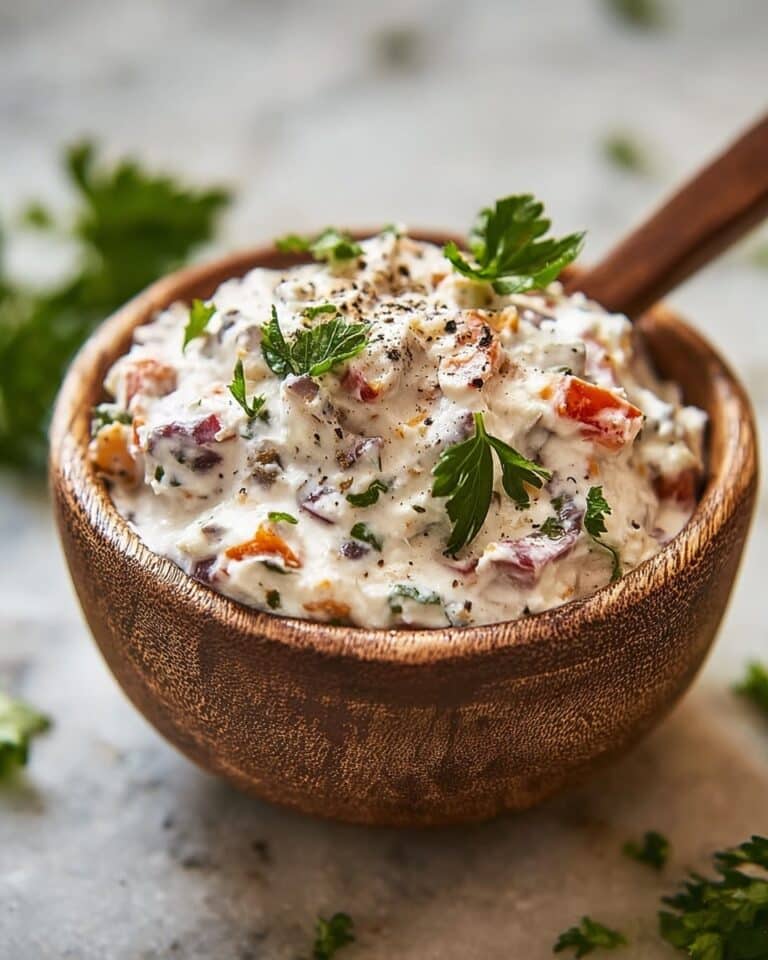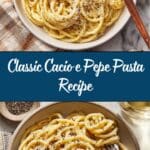Cacio e Pepe Recipe
Meet the dish that proves true culinary magic lies in simplicity: Cacio e Pepe. This iconic Roman pasta serves up big, bold flavors with only a handful of ingredients and a whisk of the wrist. Each bite bursts with sharp Pecorino Romano, the warmth of freshly cracked black pepper, and a creamy sauce that hugs every strand. If you crave comfort that comes together in just 20 minutes, Cacio e Pepe will become your go-to, just as it has for pasta lovers for centuries.
Ingredients You’ll Need

Ingredients You’ll Need
The beauty of Cacio e Pepe is how just a few pantry staples can create pure Italian bliss when treated right. Each ingredient takes center stage to build the complexity of taste, texture, and aroma in this beloved pasta.
- Spaghetti or Tonnarelli (12 ounces): Traditionalists prefer tonnarelli for its satisfyingly chewy bite, but high-quality spaghetti works perfectly if that’s what you have.
- Pecorino Romano Cheese (1 cup, finely grated): Salty, tangy, and beautifully pungent, Pecorino Romano is the signature cheese—use it freshly grated for the silkiest possible sauce.
- Freshly Cracked Black Pepper (2 teaspoons): Don’t skimp here; coarsely cracked pepper brings irresistible spice and warmth that make this dish sing.
- Unsalted Butter (2 tablespoons, optional): A modern addition for extra richness, while purists might skip it, a touch of butter creates a velvetier texture.
- Salt for Pasta Water: Season the water generously—it’s your chance to infuse the pasta itself with flavor from the very start.
How to Make Cacio e Pepe
Step 1: Cook the Pasta
Fill a large pot with water and add a generous handful of salt. Bring it to a rolling boil, then add your spaghetti or tonnarelli. Cook until just al dente—usually about a minute less than the package suggests. As the pasta cooks, scoop out about 1 and 1/2 cups of that beautifully starchy pasta water, which you’ll need for the sauce. Drain the pasta, but don’t rinse it—the starch left on the noodles is your secret weapon for creaminess.
Step 2: Toast the Black Pepper
While the pasta bubbles away, grab a large skillet and set it over medium heat. Add the cracked black pepper and toast it gently for a minute until your kitchen fills with its inviting aroma. This simple step unlocks the pepper’s warmth and infuses the oil with subtler, floral notes.
Step 3: Create the Sauce Base
Pour 1 cup of the reserved pasta water into your skillet with the toasted pepper. Let it simmer for a moment—it’ll look a bit cloudy, but that’s exactly what you want. The hot, starchy water is the backbone of the entire Cacio e Pepe sauce, so don’t rush this!
Step 4: Toss Pasta in the Peppery Water
Add your drained pasta straight to the skillet and toss it carefully using tongs. The peppery water will coat the noodles in flavor and keep everything hot—the perfect stage for a creamy cheese emulsion.
Step 5: Emulsify Cheese and Pasta
Remove the skillet from heat. Shower the grated Pecorino Romano over the pasta in small handfuls, tossing continuously with tongs after each addition. This step is the heart of Cacio e Pepe—working briskly ensures cheese melts into a glossy, clump-free sauce. Add a splash more hot pasta water as needed, aiming for a sauce that drapes every noodle luxuriously.
Step 6: Finish and Serve
If using, dot in cold butter now and toss until everything melds. Taste, adjusting with an extra crack of pepper or sprinkle of cheese as desired. Pile onto warm plates, and let your Cacio e Pepe shine while it’s piping hot!
How to Serve Cacio e Pepe
Garnishes
A final flurry of fresh Pecorino Romano and a little extra cracked pepper are the only garnishes you need—these highlight everything you love about classic Cacio e Pepe. For a dash of color, try a scatter of chopped flat-leaf parsley, but keep it minimal so the main flavors shine.
Side Dishes
Cacio e Pepe is rich and deeply savory, so pair it with simple, fresh sides. Think a crisp green salad tossed with lemony vinaigrette, or blanched seasonal vegetables like asparagus or broccolini. Warm, crusty bread is always a crowd-pleaser to swipe up any of that luscious sauce left on your plate.
Creative Ways to Present
Make your Cacio e Pepe dinner extra special by twirling the pasta into little nests with a fork and tongs, then plating individually for each guest. For a more rustic, family-style feel, dish it straight from the skillet onto a platter at the table. Some fans even serve Cacio e Pepe in edible cheese bowls for a dramatic, fun twist!
Make Ahead and Storage
Storing Leftovers
Leftover Cacio e Pepe should be cooled quickly and stored in an airtight container in the fridge, where it’ll keep for up to 3 days. The pasta may soak up some sauce and thicken, but a splash of water when reheating usually brings it right back.
Freezing
This dish is best enjoyed fresh, but you can freeze leftovers if needed. Transfer cooled portions to tightly sealed containers, squeezing out extra air. The cheese sauce may separate a little upon thawing, though a gentle stir and some added pasta water during reheating can help restore creaminess.
Reheating
Warm leftover Cacio e Pepe in a skillet over low heat with a tablespoon or two of water to loosen the sauce. Stir gently as it warms—avoid the microwave, as it can make the cheese grainy. Reheat just until hot, not bubbling, to preserve the smooth texture.
FAQs
Can I use Parmesan instead of Pecorino Romano?
While Parmesan will work in a pinch, true Cacio e Pepe gets its bold, salty tang from Pecorino Romano. Using Parmesan will yield a milder, less sharp flavor and a slightly different texture.
Why does my cheese clump instead of melting into a sauce?
Clumping happens if the cheese hits pasta that’s too hot or if it’s added all at once. Grate the Pecorino Romano very fine, remove the skillet from heat before adding, and stir constantly, adding more pasta water if needed for silky results.
Is butter traditional in Cacio e Pepe?
Classic Roman recipes skip the butter, relying only on cheese, pepper, and starchy water. However, adding butter is a modern touch that many Italians use for an extra-velvety sauce, so it’s absolutely allowed!
What type Main Course
Tonnarelli, a square-cut Roman pasta, is most authentic and pairs beautifully with this sauce. High-quality spaghetti works perfectly as well—just look for a brand with a rough texture so the sauce will cling.
Can I double the Cacio e Pepe recipe?
Yes! Just be sure to use an extra-large skillet for tossing and add cheese in stages, working quickly to keep the sauce smooth for every glorious bite.
Final Thoughts
If you’re craving an Italian classic that feels luxurious but comes together in a flash, you absolutely have to try Cacio e Pepe. It’s a stunner for both weeknight dinners and dinner parties, and every time I make it, the pure joy of that peppery, cheesy sauce never fails to delight. Give it a go—you’ll see why this Roman favorite has such a devoted following!
Print
Cacio e Pepe Recipe
- Total Time: 20 minutes
- Yield: 4 servings 1x
- Diet: Vegetarian
Description
Learn how to make the classic Italian pasta dish, Cacio e Pepe, at home with this easy and delicious recipe. With just a few simple ingredients, you can create a creamy and flavorful pasta dish that will transport you to the streets of Rome.
Ingredients
Ingredients:
- 12 ounces spaghetti or tonnarelli
- 1 cup finely grated Pecorino Romano cheese
- 2 teaspoons freshly cracked black pepper
- 2 tablespoons unsalted butter (optional)
- salt for pasta water
Instructions
- Cook the Pasta: Bring a large pot of salted water to a boil and cook the pasta until al dente, reserving 1 1/2 cups of the starchy pasta water before draining.
- Toast the Pepper: In a large skillet over medium heat, toast the cracked black pepper for about 1 minute until fragrant.
- Make the Sauce: Add 1 cup of the reserved pasta water to the skillet and bring to a simmer. Add the cooked pasta to the skillet and toss to coat. Remove from heat and gradually sprinkle in the grated Pecorino Romano cheese while tossing the pasta continuously to create a creamy sauce, adding more reserved pasta water as needed until the sauce coats the noodles smoothly.
- Finish and Serve: If using, add butter for extra richness. Serve immediately with additional cracked black pepper and Pecorino Romano.
Notes
- Use freshly grated Pecorino Romano for the best texture.
- Work quickly when adding the cheese to prevent clumping.
- Prep Time: 5 minutes
- Cook Time: 15 minutes
- Category: Main Course
- Method: Stovetop
- Cuisine: Italian
Nutrition
- Serving Size: 1 bowl
- Calories: 520
- Sugar: 2g
- Sodium: 500mg
- Fat: 18g
- Saturated Fat: 10g
- Unsaturated Fat: 7g
- Trans Fat: 0g
- Carbohydrates: 68g
- Fiber: 3g
- Protein: 20g
- Cholesterol: 45mg






